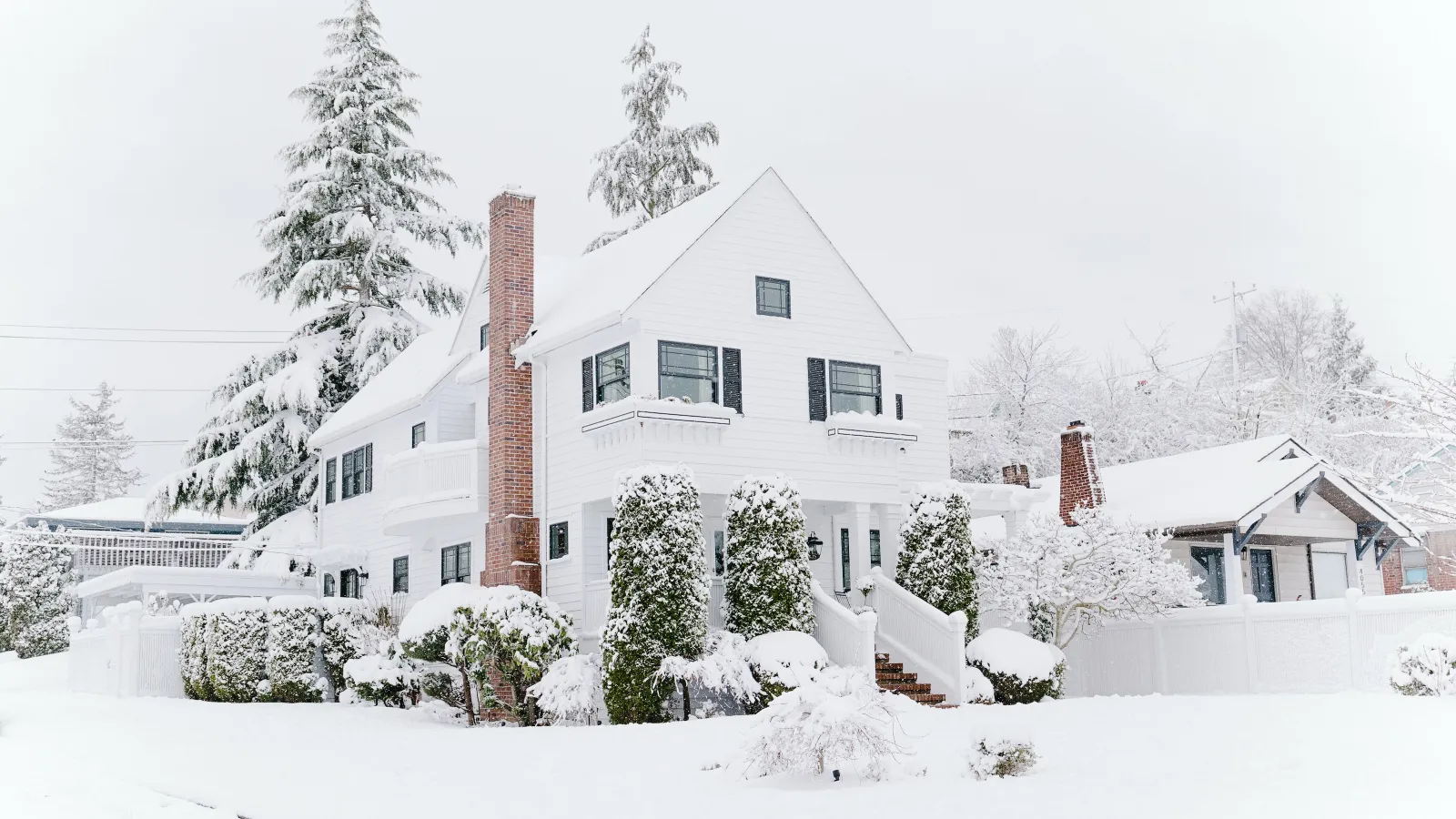5 Questions About Winterizing Your Home

Are you tired of rising utility costs every winter? Well, there are a variety of things a homeowner can do to help reduce their winter expenses. Frequently, these actions are called weatherizing or winterizing your home. If this sounds complicated, then rest assured, there are some frequently asked questions about the process. We hope the following helps enlighten homeowners about winterization and explains the DIY basics from professional assistance.
What Is weatherization?
For inexperienced homeowners, there might be some ambiguity between weatherization and winterization, however, these are essentially same things. From Wikipedia: winterization is preparing something for winter.
However, that does not help homeowners because it lacks details, such as, what are those preparations?
Winterization actions are home improvement, modifications and/or repairs that help neutralize the impact of cold weather.
Winterization helps homeowners prevent cold air from influencing the warm interior air.
How does winterizing work?
Insulation and air sealing are the critical steps to properly restricting the air from flowing out of your home. Winterization works by identifying "leaks" in the interior/exterior of the house. From our high school science class, which we tried to forget, we know that hot air rises. Therefore, in the winter, the air heated to keep your family warm rises. Because air is a gas, minuscule gaps (not seen by the human eye) allow hot air to escape. Winterization works by stopping the air from escaping.
As Art of Manliness notes, according to the US Department of Energy, air drafts cause about 5-30% of home energy use to be wasted. However, there are some professional (like proper insulation and air duct sealing) and DIY actions to restrict this unnecessary energy waste.
You're likely to find drafts underneath doors and near windows. If you find a leak underneath your door put a draft snake across the bottom of it. A simple rolled up bath towel will work. If you have leaks near your windows, get some weather-resistant caulk and caulk them from the outside. You can use weather stripping as well. Other places you might want to check for leaks are where pipes and wires exit your foundation.
Winterizing Your Home Reduces Mold & Mildew
Winterization also protects homes from water drainage issues. Mold and mildew, which create year round concerns, are often caused by porous foundations that are common in older homes. These homes frequently suffer from moisture and water drainage issues. Dehumidifiers and sump pumps counteract the moisture buildup.
However, these are stop gaps and do not address the root problem. The core problem relates to moisture-filled air seeping into the house and condensing in the hot/cold air dance. Again, proper insulation and air sealing prevents the interior and exterior air from entering and leaving the house, which helps eliminate the moisture inside the house.
What are the benefits of winterization?
The primary benefit of winterization is lower bills. There are some residual benefits, but saving money is the main reason why homeowners undertake the winterization process. Related, these steps also protect the long term value of your home because (as noted) they prevent mold, mildew and moisture buildup that can cause damage to your home over time.
Additionally, winterizing your home yields benefits, such as improving indoor air quality and energy efficiency, which improves the environment.
Improving your home airflow through insulation benefits you because heating (and cooling) systems do not work as hard. The reduced workload means less energy costs because the HVAC system is not constantly in use during the winter, which translates into reduced savings for you, the homeowner.
Another great benefit of winterization is improved air quality. Particularly in the Atlanta area, air quality can be an issue. To really generate benefits of winterization, then consider a professional inspection of your furnace and heating ducts. If these units are old and dirty, then that filth infects the air that is blown throughout your home. Following the inspection, then homeowners can set a schedule to check and replace, as needed, the furnace filter. Furnace filter replacements are something any homeowner can complete.
What are the costs associated with winterization?
It might sound counterintuitive, but prior to taking any action (particularly for your initial winterization campaign) then complete a home energy checkup. The energy checkup is vital to understanding what needs modifications and/or repairs, if any. An energy checkup helps identify air leakage, which means you'll understand where money is seeping through your house.
The initial effort to winterize your home can be quite costly, especially if you have an old home. However, there are government subsidies (such as the George weatherization assistance program) and financing available, as well as tax rebates that can offset some of the upfront costs. It is important to weigh the costs against the long term savings as well.
Debbie Markman, Economic Security Corporation Resource Development Director provided some information for National Weatherization Day, where some municipalities weatherize homes in low-income neighborhoods.
Once work is complete, officials expect the changes to have an impact of at least 35%. Homeowners will see about a 35% decrease in their electric bill. Organizers say working together is key to making a project like this possible.
What are the basic DIY steps?
For DIY homeowners, some basic actions make an immediate impact. Plus, they are cost-effective. To start, remember that air leakage is the primary action that you are trying to contain. As a result, it is important to understand the building envelope. Although this sounds technical, the building envelope is simply the physical barrier between the interior and exterior of a building. The main items of the building envelope are:
- Windows.
- Doors.
- Roofs.
Develop a Winterizing Your Home Checklist
Now that you know to concentrate your efforts on places where the interior and exterior are adjacent, find or develop a checklist (available for download). It may take some time to work through the items to check and perhaps modify or repair, so start soon!
Stop Air Leaks
Obviously, doors are a major place for air leaks. However, another overlooked area are power outlets. For DIYers, then there are some simple ways to make your own draft dodger and insulate power outlets. Important note, that insulating power outlets could be a major fire hazard. Please follow instructions carefully or have a professional insulate (or inspect) the outlets.
Protect Your Family
Winterizing your home protects your family. We want to keep your family comfortable, which means warm in the winter. At the same time, we don't want to constantly worry about the temperature inside and pending heating bill.
Another safety issue are the smoke detector and carbon monoxide detector. As the Art of Manliness notes, homeowners should be aware of the downstream effects of overused and outdated appliances. Check these detectors as part of the winterization process.
Winter sees an uptick in the number of home fires and cases of carbon monoxide poisoning because people are running their furnaces and boilers over time in order to keep warm. To keep your family safe, check the batteries on your smoke and carbon monoxide detectors and change them if needed.
Winterize Your Yard
Not everything involves doors and air ducts. There is also yard work! Winter storms include heavy rain, sleet and possibly snow on trees. While the weather permits, trim any trees that are near your home to prevent damage. Also, clean the gutters and possibly install leaf guards to help proper drainage of snow and rain. Ensure water has a clear path to prevent buildup that may lead to ice dams during cold and freezing temperatures.
Protect Your AC Unit
Another appliance to consider is the air conditioner unit. Most likely, you will not use your AC unit during the winter. If that is the case, then winterizing your AC should extend its life, plus it is pretty easy.
- Drain any pipes or hoses (so they don't freeze).
- Vacuum out any pools of water in the drain pan.
- Cover the central air unit with a plastic air conditioner cover (which keeps rain/sleet/snow out and prevents rusting).
For any and all winterization questions, then Snappy Electric, Plumbing, Heating, & Air has the expertise to answer your specific questions. Homeowners should consider a home energy checkup because the findings truly identify the gaps where air leakage occurs and will save you money over time.
We hope this was helpful and explain what, why, and how winterization works to protect your home value, family safety and save some money over time. Please feel free to reach out to Snappy Electric, Plumbing, Heating, & Air with any questions or schedule a service!

